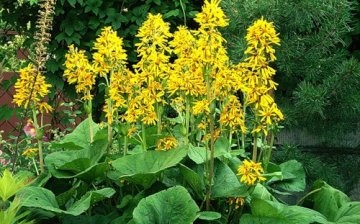Inhabitant of eastern wet meadows
But in Russia, too, some varieties of Buzulnik are doing quite well. The scientific name of this species is Ligularia, and among the people it is also called "tongue". It is a relative of the aster, numbering about 150 species. On sale most often you can find only two or three of the most common, and one of them is a toothed buzulnik.
Buzulnik serrated has decorative inflorescences, and no less attractive leaves. Wide, rounded, with jagged edges, they form an interesting bush that attracts the attention of others. In autumn, the leaves take on an interesting reddish tint. Buzulnik blooms for about a month and a half, starting in July-August. Inflorescences racemose, densely covered with bright yellow flower heads. A tall, powerful plant more than a meter high will certainly not get lost in your garden plot.
Since the buzulniks come from the wet meadows of China and Japan, they do not like sun-drenched places, but prefer partial shade. If it has already grown in the sun, then it will require frequent watering in hot weather. The soil can be almost any. But if it is poor, then it is better to feed a little for better flowering. Plant transplants are not required. It can grow in your garden for up to 20 years without being exposed to diseases and pests, making up a part of a living flower arrangement in your backyard landscape design. It is recommended to cut off the aerial part of the bush before the onset of winter.
There are two varieties of the toothed buzulnik under the legendary names: Othello and Desdemona. This plant can be grown and propagated either by seeds or by dividing the bush.



